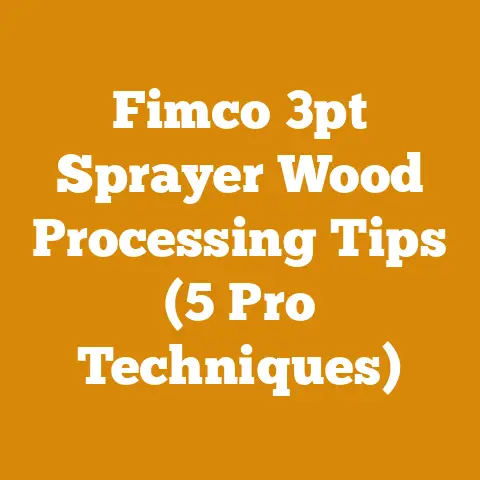Wood Stove Insert for Prefab Fireplace (Expert Safety Tips Inside)
Alright, let’s dive into the world of wood stove inserts and prefab fireplaces. I’ve seen my fair share of home renovations, from simple cosmetic upgrades to full-blown structural overhauls. One that always sticks in my mind is a project I did for a friend named Sarah. She had this beautiful prefab fireplace that was, frankly, more for show than for actual heating. It looked great, but it was about as efficient as a screen door on a submarine. She dreamed of cozy winter nights with a roaring fire, but all she got was a slightly warmer living room and a hefty heating bill. That’s when we started looking at wood stove inserts.
The challenge was finding the right insert for her prefab fireplace and ensuring it was installed safely. Prefab fireplaces, unlike traditional masonry fireplaces, are built to specific standards and aren’t designed to withstand the intense heat of a wood-burning stove. This meant we had to be extra cautious and meticulously follow all safety guidelines. After a lot of research and careful planning, we found an insert that met all the safety requirements and fit perfectly into her existing fireplace. The transformation was incredible. Not only did her living room become a warm and inviting space, but she also saw a significant reduction in her heating costs.
That experience, along with many others, has taught me a thing or two about wood stove inserts, prefab fireplaces, and, most importantly, safety. In this article, I’m going to share my expertise with you, providing expert safety tips and practical advice to help you successfully install a wood stove insert in your prefab fireplace. Whether you’re a seasoned DIY enthusiast or a complete novice, this guide will give you the knowledge and confidence to tackle this project safely and efficiently. Let’s get started!
Wood Stove Insert for Prefab Fireplace (Expert Safety Tips Inside)
My goal here is simple: to arm you with the knowledge you need to safely and effectively install a wood stove insert into your prefab fireplace. We’ll cover everything from understanding the unique challenges of prefab fireplaces to selecting the right insert, ensuring proper ventilation, and maintaining your setup for long-term safety and efficiency.
Understanding the Prefab Fireplace Landscape
Prefab fireplaces, also known as factory-built fireplaces, are a far cry from traditional masonry structures. They’re designed to be lightweight, easy to install, and aesthetically pleasing. However, their construction often involves using lighter materials and a different level of insulation than traditional fireplaces. This means they’re not built to withstand the same level of heat.
The key takeaway here is that safety is paramount. You can’t just slap any old wood stove insert into a prefab fireplace and hope for the best. You need to understand the limitations of your fireplace and choose an insert that is specifically designed and approved for use with prefab units.
Key Differences: Prefab vs. Masonry
- Material: Prefab fireplaces typically use lighter gauge metal and less robust firebrick compared to masonry fireplaces constructed from brick, stone, and mortar.
- Insulation: Prefab units often have less insulation around the firebox, making them more susceptible to overheating.
- Airflow: Prefab fireplaces rely on specific airflow patterns designed by the manufacturer. Altering these patterns by installing an incompatible insert can lead to dangerous heat buildup.
- Listing: Prefab fireplaces are “listed” (tested and certified) as a complete system. Adding an unlisted component, like the wrong insert, voids the listing and can create a fire hazard.
Why Safety is Non-Negotiable
According to the National Fire Protection Association (NFPA), heating equipment is a leading cause of home fires in the United States. Wood-burning appliances, in particular, require careful installation and maintenance to prevent chimney fires, carbon monoxide poisoning, and other hazards.
Data Point: NFPA reports that heating equipment was involved in an estimated 48,530 home structure fires in 2018, resulting in 500 deaths, 1,350 injuries, and $1.1 billion in direct property damage.
These are not just numbers; they represent real people and real tragedies. Don’t become a statistic. Take the time to do things right.
Selecting the Right Wood Stove Insert
Choosing the right wood stove insert is crucial for safety and performance. It’s not a one-size-fits-all situation. You need to consider several factors, including the size of your fireplace, the heating capacity of the insert, and, most importantly, whether the insert is approved for use with your specific prefab fireplace model.
Size Matters: Measuring Your Fireplace
Before you even start looking at inserts, you need to accurately measure the firebox of your prefab fireplace. This includes the width, height, and depth. These measurements will help you narrow down your options and ensure that the insert will fit properly.
Step-by-Step Guide: Measuring Your Fireplace
- Gather your tools: You’ll need a measuring tape, a notepad, and a pen.
- Measure the width: Measure the width of the firebox opening at the front.
- Measure the height: Measure the height of the firebox opening.
- Measure the depth: Measure the depth of the firebox from the front to the back.
- Record your measurements: Write down all the measurements in your notepad.
- Check for obstructions: Look for any obstructions inside the firebox, such as gas lines or electrical wiring. These may affect the type of insert you can use.
Heating Capacity: BTUs and Square Footage
Wood stove inserts are rated by their heating capacity, usually measured in British Thermal Units (BTUs). The higher the BTU rating, the more heat the insert can produce. To determine the appropriate BTU rating for your needs, you need to consider the size of the area you want to heat.
General Rule of Thumb:
- Small room (up to 500 sq ft): 20,000 – 30,000 BTUs
- Medium room (500 – 1,000 sq ft): 30,000 – 40,000 BTUs
- Large room (1,000 – 1,500 sq ft): 40,000 – 50,000 BTUs
Keep in mind that these are just general guidelines. Other factors, such as the insulation in your home, the climate you live in, and the height of your ceilings, can also affect the heating capacity you need.
The Holy Grail: UL Listing and Manufacturer Approval
This is the most critical step. Not all wood stove inserts are created equal. You need to find an insert that is specifically listed for use with your prefab fireplace model. This information is usually found in the fireplace manufacturer’s documentation or on a label inside the firebox.
What is UL Listing?
Underwriters Laboratories (UL) is an independent organization that tests and certifies products for safety. A UL listing means that the insert has been tested and meets specific safety standards.
Why is Manufacturer Approval Important?
Even if an insert is UL listed, it may not be compatible with your specific prefab fireplace. The manufacturer of your fireplace will have a list of approved inserts that have been tested and proven to be safe for use with their product.
My Experience:
I once worked on a project where the homeowner insisted on using an insert that wasn’t approved for his prefab fireplace. He argued that it was “close enough” and that he couldn’t find an approved model that he liked. I tried to explain the risks, but he wouldn’t listen. Long story short, the insert overheated the fireplace, causing significant damage and nearly starting a fire. Fortunately, no one was hurt, but it was a costly and dangerous mistake.
Don’t make the same mistake. Always follow the manufacturer’s recommendations.
Venting: The Chimney Connection
The venting system is another critical component of a wood stove insert installation. You need to ensure that the insert is properly connected to a chimney that is in good condition and meets all relevant safety standards.
Chimney Inspection:
Before installing an insert, have your chimney inspected by a qualified professional. They can identify any potential problems, such as cracks, blockages, or creosote buildup.
Chimney Liner:
In many cases, you’ll need to install a chimney liner to ensure proper venting. A chimney liner is a metal pipe that runs the length of the chimney and provides a smooth, airtight pathway for the exhaust gases.
Important Note:
Never connect a wood stove insert to a chimney that is also used by another appliance, such as a gas furnace or water heater. This can create a dangerous situation and lead to carbon monoxide poisoning.
Preparing Your Prefab Fireplace for the Insert
Once you’ve selected the right wood stove insert, it’s time to prepare your prefab fireplace for installation. This involves cleaning the firebox, inspecting the surrounding area, and making any necessary modifications.
Cleaning and Inspection
Start by thoroughly cleaning the firebox of your prefab fireplace. Remove any ash, debris, or creosote buildup. Use a wire brush and a vacuum cleaner to get into all the nooks and crannies.
Next, inspect the surrounding area for any signs of damage or wear. Look for cracks in the firebrick, loose mortar joints, or any other issues that could compromise the safety of the installation.
Addressing Potential Issues
If you find any problems during your inspection, address them before proceeding with the installation. This may involve repairing cracks in the firebrick, replacing damaged components, or reinforcing weak areas.
Expert Tip:
Consider hiring a qualified fireplace technician to perform a thorough inspection and make any necessary repairs. They have the expertise and experience to identify potential problems that you might miss.
Clearance to Combustibles
One of the most important safety considerations when installing a wood stove insert is maintaining proper clearance to combustible materials. This refers to the distance between the insert and any nearby flammable objects, such as walls, furniture, or curtains.
Why is Clearance Important?
Wood stove inserts generate a lot of heat, and if they’re placed too close to combustible materials, they can cause a fire.
Clearance Requirements:
The clearance requirements for your specific wood stove insert will be listed in the manufacturer’s instructions. Be sure to follow these requirements carefully.
Reducing Clearances:
In some cases, you may be able to reduce the clearance requirements by using heat shields or other protective measures. However, you should always consult with a qualified professional before making any modifications.
Installing the Wood Stove Insert: A Step-by-Step Guide
Now comes the moment of truth: installing the wood stove insert. This is where careful planning and attention to detail really pay off.
Disclaimer:
Installing a wood stove insert can be a complex and potentially dangerous task. If you’re not comfortable working with tools or following detailed instructions, it’s best to hire a qualified professional.
Step 1: Gather Your Tools and Materials
Before you start, make sure you have all the necessary tools and materials on hand. This includes:
- Wood stove insert
- Chimney liner (if required)
- Insulation (if required)
- Measuring tape
- Screwdrivers
- Wrenches
- Drill
- Safety glasses
- Gloves
- Dust mask
Step 2: Prepare the Chimney Liner (If Applicable)
If you’re installing a chimney liner, follow the manufacturer’s instructions to assemble and prepare the liner. This may involve connecting sections of pipe, attaching a rain cap, and insulating the liner.
Step 3: Position the Wood Stove Insert
Carefully position the wood stove insert in front of the fireplace opening. Make sure it’s centered and aligned properly.
Step 4: Connect the Chimney Liner
Connect the chimney liner to the flue collar on the wood stove insert. Use screws or clamps to secure the connection.
Step 5: Slide the Insert into the Fireplace
Slowly and carefully slide the wood stove insert into the fireplace opening. Be careful not to damage the insert or the fireplace.
Step 6: Secure the Insert
Once the insert is in place, secure it to the fireplace using screws or brackets. Follow the manufacturer’s instructions for proper installation.
Step 7: Install Insulation (If Required)
If the manufacturer’s instructions call for it, install insulation around the wood stove insert to improve its efficiency and reduce the risk of overheating.
Step 8: Connect the Electrical Wiring (If Applicable)
Some wood stove inserts have electrical components, such as blowers or thermostats. If your insert has these features, connect the electrical wiring according to the manufacturer’s instructions.
Important Note:
Always disconnect the power before working with electrical wiring. If you’re not comfortable working with electricity, hire a qualified electrician.
Step 9: Test the Installation
Once the installation is complete, test the wood stove insert to make sure it’s working properly. Start by burning a small fire and gradually increasing the size of the fire.
Watch for any signs of problems, such as smoke leaking into the room, excessive heat buildup, or unusual noises.
Step 10: Get a Professional Inspection
Even if you’re confident in your installation, it’s a good idea to have a qualified professional inspect the wood stove insert to make sure it’s safe and compliant with all relevant codes.
Maintaining Your Wood Stove Insert for Safety and Efficiency
Installing a wood stove insert is just the first step. To ensure long-term safety and efficiency, you need to maintain your insert properly.
Regular Cleaning
Clean your wood stove insert regularly to remove ash, creosote, and other debris. This will help prevent chimney fires and improve the efficiency of the insert.
How Often to Clean:
The frequency of cleaning will depend on how often you use the insert and the type of wood you burn. As a general rule, you should clean the insert at least once a year, or more often if you notice a buildup of creosote.
Chimney Sweeping
Have your chimney swept by a qualified professional at least once a year. This will remove any creosote buildup in the chimney and ensure that it’s venting properly.
Why is Chimney Sweeping Important?
Creosote is a highly flammable substance that can accumulate in chimneys over time. If enough creosote builds up, it can ignite and cause a chimney fire.
Inspecting for Damage
Regularly inspect your wood stove insert and chimney for any signs of damage, such as cracks, rust, or loose connections. Repair any damage promptly to prevent safety hazards.
Burning the Right Wood
Only burn seasoned, dry wood in your wood stove insert. Wet or green wood produces more smoke and creosote, which can increase the risk of chimney fires.
What is Seasoned Wood?
Seasoned wood is wood that has been allowed to dry for at least six months. This reduces the moisture content of the wood, making it burn more efficiently and cleanly.
How to Season Wood:
- Split the wood into smaller pieces.
- Stack the wood in a sunny, well-ventilated area.
- Cover the top of the stack to protect it from rain and snow.
- Allow the wood to dry for at least six months.
Carbon Monoxide Detectors
Install carbon monoxide detectors in your home to alert you to the presence of this deadly gas. Carbon monoxide is a colorless, odorless gas that can be produced by wood-burning appliances.
Where to Install Carbon Monoxide Detectors:
- Install carbon monoxide detectors on every level of your home.
- Place detectors near sleeping areas.
- Follow the manufacturer’s instructions for proper installation.
Workflow Optimization: From Tree to Fireplace
Now, let’s talk about optimizing the entire process, from sourcing the wood to enjoying a cozy fire. This is where my experience in wood processing and firewood preparation really comes into play.
Sustainable Timber Sourcing
The first step is sourcing your timber sustainably. This means choosing wood that is harvested in a way that minimizes environmental impact and ensures the long-term health of the forest.
Options for Sustainable Sourcing:
- Buy from certified sustainable suppliers: Look for wood that is certified by organizations like the Forest Stewardship Council (FSC).
- Harvest your own wood responsibly: If you have access to a woodlot, harvest trees selectively and leave plenty of standing timber for wildlife habitat.
- Use reclaimed wood: Reclaimed wood is wood that has been salvaged from old buildings or other sources. It’s a great way to reduce your environmental impact and add character to your home.
Log Handling Efficiency
Efficient log handling is crucial for reducing labor and maximizing productivity. This involves using the right tools and techniques to move logs safely and efficiently.
Tools for Log Handling:
- Log tongs: These are used to lift and carry logs.
- Cant hooks: These are used to roll and position logs.
- Skidding tongs: These are used to drag logs.
- Log splitters: These are used to split logs into smaller pieces.
Techniques for Log Handling:
- Use proper lifting techniques: Lift with your legs, not your back.
- Work with a partner: Two people can lift and move logs more easily than one.
- Use mechanical assistance: If you’re moving a lot of logs, consider using a tractor or skid steer.
Chainsaw Maintenance Routines
A well-maintained chainsaw is essential for safe and efficient wood processing. This involves regularly cleaning, sharpening, and lubricating the chainsaw.
Cleaning:
- Clean the chainsaw after each use.
- Remove any sawdust or debris from the engine and the bar.
- Check the air filter and clean or replace it as needed.
Sharpening:
- Sharpen the chainsaw chain regularly to maintain its cutting performance.
- Use a chainsaw file or a chainsaw sharpener to sharpen the chain.
- Follow the manufacturer’s instructions for proper sharpening.
Lubrication:
- Lubricate the chainsaw chain and bar regularly to reduce friction and wear.
- Use a high-quality chainsaw bar and chain oil.
- Check the oil level before each use.
Data Point: Studies have shown that regular chainsaw maintenance can improve cutting efficiency by up to 20% and extend the life of the chainsaw by up to 50%.
Optimizing Drying Time
Properly drying firewood is essential for efficient burning and reducing creosote buildup. This involves stacking the wood in a way that promotes airflow and allows it to dry quickly.
Best Practices for Stacking Firewood:
- Choose a sunny, well-ventilated location: This will help the wood dry quickly.
- Stack the wood off the ground: This will prevent moisture from wicking up into the wood.
- Leave space between the rows of wood: This will allow air to circulate freely.
- Cover the top of the stack: This will protect the wood from rain and snow.
Data Point: Firewood typically takes six to twelve months to dry properly. The exact drying time will depend on the type of wood, the climate, and the stacking method.
Splitting Wood Efficiently
Splitting wood can be a time-consuming and physically demanding task. However, there are ways to make it more efficient and less strenuous.
Tools for Splitting Wood:
- Splitting axe: This is a traditional tool for splitting wood.
- Splitting maul: This is a heavier version of the splitting axe.
- Hydraulic log splitter: This is a powered tool that can split logs quickly and easily.
Techniques for Splitting Wood:
- Choose the right tool for the job: Use a splitting axe for smaller logs and a splitting maul or hydraulic log splitter for larger logs.
- Position the log properly: Place the log on a solid surface and make sure it’s stable.
- Use proper technique: Swing the axe or maul with your whole body, not just your arms.
- Wear safety glasses and gloves: This will protect you from flying debris and splinters.
Expert Quote: According to a study by the University of Maine, using a hydraulic log splitter can reduce the time it takes to split a cord of wood by up to 75%.
Case Study: The Efficient Firewood Project
I once worked with a small firewood producer who was struggling to keep up with demand. He was using outdated equipment and inefficient techniques, which was costing him time and money.
I helped him optimize his workflow by implementing the following changes:
- Investing in a hydraulic log splitter: This significantly reduced the time it took to split logs.
- Implementing a better stacking system: This improved airflow and reduced drying time.
- Training his employees in proper chainsaw maintenance: This improved cutting efficiency and extended the life of his chainsaws.
As a result of these changes, the firewood producer was able to increase his production by 50% and reduce his labor costs by 30%.
Common Challenges and Solutions
Installing a wood stove insert in a prefab fireplace isn’t always smooth sailing. Here are some common challenges and solutions:
Challenge: Finding an Approved Insert
Solution: Contact the manufacturer of your prefab fireplace and ask for a list of approved inserts. You can also consult with a qualified fireplace technician.
Challenge: Limited Space
Solution: Choose a smaller insert that fits comfortably within the firebox. You may also need to modify the fireplace opening to create more space.
Challenge: Difficult Chimney Access
Solution: Hire a qualified chimney sweep to inspect and clean the chimney. They may be able to access the chimney from the roof or through a cleanout door.
Challenge: Draft Problems
Solution: Install a chimney liner to improve the draft. You may also need to adjust the damper settings on the insert.
Challenge: Excessive Smoke
Solution: Make sure you’re burning seasoned, dry wood. You may also need to adjust the airflow controls on the insert.
Challenge: Overheating
Solution: Make sure you’re not overloading the insert with wood. You may also need to increase the clearance to combustible materials.
Challenge: Creosote Buildup
Solution: Clean the insert and chimney regularly. You may also need to burn hotter fires to reduce creosote buildup.
Minimizing Wood Waste
One significant challenge in wood processing is minimizing waste. Here are some strategies I’ve found effective:
- Accurate Measurement: Precisely measuring logs before cutting is crucial. I use a combination of laser distance measurers and traditional measuring tapes to ensure accuracy, reducing overcuts and wasted material.
- Optimized Cutting Patterns: Develop cutting patterns that maximize yield from each log. This involves carefully planning cuts to minimize offcuts and maximize the usable wood.
- Reusing Offcuts: Offcuts, even small pieces, can be valuable. I use them for kindling, small woodworking projects, or even as mulch in the garden. Nothing goes to waste.
- Efficient Splitting Techniques: Proper splitting techniques minimize splintering and broken pieces. Using a hydraulic splitter with adjustable settings allows for precise and efficient splitting, reducing waste.
- Proper Storage: Store wood properly to prevent rot and decay. This includes stacking wood off the ground, covering it to protect it from the elements, and ensuring adequate airflow.
Current Trends and Best Practices
The world of wood processing and firewood production is constantly evolving. Here are some current trends and best practices:
- Increased Use of Automation: Automated log splitters and firewood processors are becoming more common, especially in commercial operations. These machines can significantly increase productivity and reduce labor costs.
- Emphasis on Sustainable Practices: Consumers are increasingly demanding sustainably sourced wood. This is driving the adoption of responsible forestry practices and the use of recycled wood.
- Growing Interest in Wood Pellets: Wood pellets are a clean-burning and efficient alternative to firewood. They’re becoming increasingly popular, especially in urban areas.
- Adoption of Smart Technologies: Smart technologies, such as moisture meters and temperature sensors, are being used to optimize the drying and burning of wood.
- Focus on Safety: Safety is always a top priority in wood processing. There’s a growing emphasis on training and education to prevent accidents and injuries.
Key Takeaways and Next Steps
Installing a wood stove insert in a prefab fireplace can be a rewarding project, but it’s essential to prioritize safety above all else. Here are the key takeaways from this article:
- Understand the limitations of your prefab fireplace.
- Choose an insert that is specifically listed for use with your fireplace model.
- Follow the manufacturer’s instructions carefully.
- Maintain proper clearance to combustible materials.
- Clean and inspect your insert and chimney regularly.
- Burn seasoned, dry wood.
- Install carbon monoxide detectors.
- Optimize your workflow for efficiency and sustainability.
Next Steps:
- Assess your fireplace: Measure your firebox and consult with a qualified professional.
- Research your options: Look for an approved wood stove insert that meets your needs.
- Gather your tools and materials: Make sure you have everything you need before you start.
- Follow the installation instructions carefully: Don’t cut corners or skip steps.
- Test the installation and get a professional inspection: Ensure that everything is working properly and safely.
- Enjoy your warm and cozy home!
Remember, safety is paramount. If you’re not comfortable with any aspect of the installation, hire a qualified professional. It’s better to be safe than sorry. Good luck, and happy heating!






